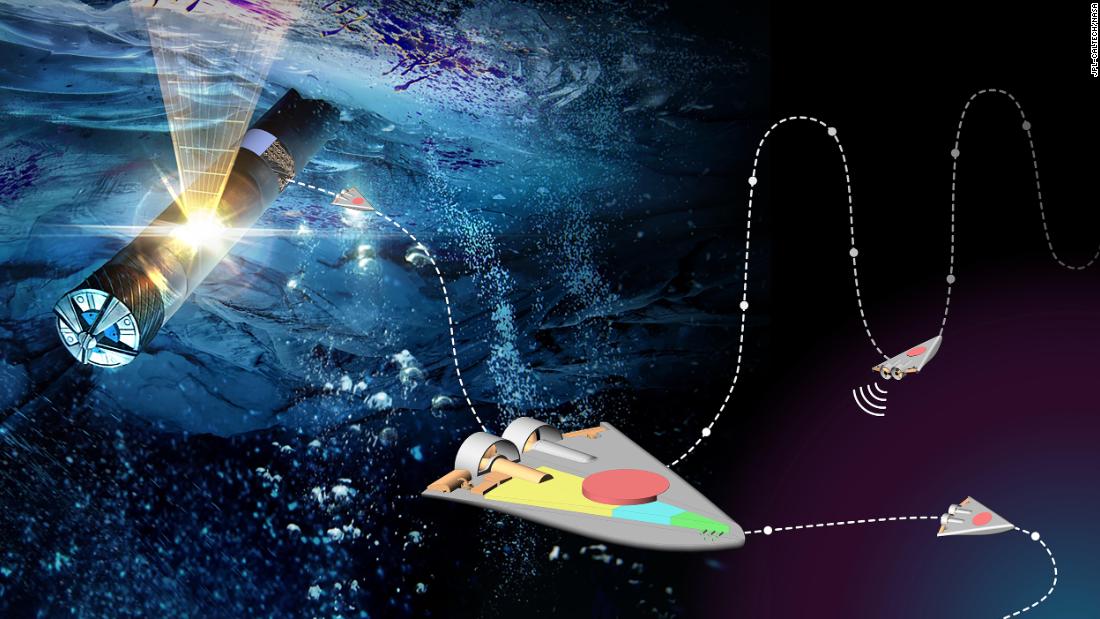Beneath a thick, icy shell, Jupiter’s moon Europa and Saturn’s moons Titan and Enceladus likely harbor oceans, scientists say. On Earth, the oceans teem with life, but is the same scenario possible on these frosty moons?
But exploring the difficult terrain as well as the oceans themselves may require technology that feels more like science fiction.
Here are some of the concepts experts are exploring at NASA’s Jet Propulsion Laboratory in Pasadena, California, that could one day turn into an ice-diving mission to alien worlds.
ice jump
Little is known about the frozen terrain covering Europa and Enceladus, so any mission exploring the surface of these worlds could potentially have to navigate dangerous landscapes.
A concept called SPARROW, or the Steam-Powered Autonomous Recovery Robot for Ocean Worlds, would be able to jump over any hazards such as long blades of ice called penitents.
“The terrain on Europa is likely very complex,” JPL roboticist and lead concept researcher Gareth Meirion-Griffith said in a statement. “It could be porous, it could be riddled with crevices, there could be penitents several meters tall that would stop most robots in their tracks. But SPARROW has complete agnosticism of the terrain; it has complete freedom to move through otherwise inhospitable terrain.”
The concept includes a lander that serves as the base for a spherical robot. This ball, which looks like a cage and is about the size of a soccer ball, would include instruments and propellants.
Rather than relying on fuel, the SPARROW Ball would use steam created from melting ice. The low gravity of the ocean worlds would allow the ball and its steam-powered thrusters to leap for miles.
The lander would collect and melt ice, then load water into SPARROW. The robotic ball’s motors could heat up the water to create a burst of steam.
Instruments on board SPARROW could be used to collect samples that could be analyzed on the lander.
And multiple SPARROWs may be better than one to explore these mysterious and distant worlds.
Traveling underwater
The Buoyant Rover for Under-Ice Exploration, or BRUIE, would act much the same way – just inside an ocean on Enceladus or Europa, rather than on land.
A rover exploring an ocean world will have to navigate alone. The BRUIE prototype is about 3 feet (1 meter) long and has two wheels to help it roll upside down on ice. The images and data collected by the floating rover will allow scientists to study the “ice-water interface”.
“We found that life often lives at interfaces, both at the bottom of the sea and at the ice-water interface at the top. Most submersibles find it difficult to investigate this area because ocean currents could make them crash, or they’d waste too much of a power-sustaining position,” Andy Klesh, chief concept engineer, said in a statement.
“BRUIE, however, uses buoyancy to stay anchored against the ice and is impervious to most currents. Plus, it can safely power off, only turning on when it needs to take a measurement, so that he can spend months observing the ice environment.”
JPL engineers have already put the rover through its paces in similar environments on Earth in the Arctic, Alaska and Antarctica.
“The ice shells covering these distant oceans serve as a window to the oceans below, and the chemistry of the ice could help sustain life in these oceans,” said Kevin Hand, JPL’s lead scientist for the BRUIE project, in a statement. “Here on Earth, the ice covering our polar oceans plays a similar role, and our team is particularly interested in what happens where water meets ice.”
swim under the ice
A small but mighty approach is a concept that would pack cellphone-sized swimming robots inside a probe called a cryobot that could swoop through the ice crust on Europa and Enceladus. Once underwater, the fleet of tiny swimmers could freely explore the alien ocean.
The Sensing With Independent Micro-Swimmers, or SWIM, concept has received $600,000 in funding in the second phase of NASA’s Innovative Advanced Concepts program, which will test prototypes.
“My idea is, where can we take miniaturized robotics and apply them in exciting new ways to explore our solar system?” Ethan Schaler, a robotic mechanical engineer at JPL, said in a statement. “With a swarm of small swimming robots, we are able to explore a much larger volume of ocean water and improve our measurements by having multiple robots collecting data in the same area.”
Each swimming robot is said to be about 5 inches (12.7 centimeters) long, and about four dozen of them could fit inside a part of a cryobot measuring 10 inches (25.4 centimeters) in diameter . There would still be room for scientific instruments in the probe, which will rely on a hot nuclear battery to melt the ice.
The home base of the cryobot would be a surface lander, which would serve as a communication relay between the probe and the Earth.
The swimming robots would each have their own propulsion, computer and ultrasonic communication, as well as sensors capable of recording temperature, pressure, acidity and salinity. During the second phase, Schaler will add chemical sensors that could look for signs of life.
“What if, after all those years it took to enter an ocean, you walked through the ice shell in the wrong place? What if there were signs of life there but not where you entered. the ocean ?” said JPL SWIM team scientist Samuel Howell, who is also working on the Europa Clipper. “By bringing these robot swarms with us, we would be able to look ‘out there’ to explore much more of our environment than a single cryobot would allow.”

